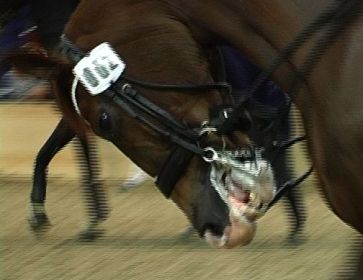Blue Tongue Dressage Outrage Goes Viral and Global; Rollkur Opponents See Abuse on Video, What Do You See?
- March 10, 2017
- ⎯ Fran Jurga
by Fran Jurga | 23 October 2009 | The Jurga Report at Equisearch.com
It was just a video clip posted on YouTube. But in a few days, 19,835 people all over the world had seen it.
It was just a group page on FaceBook. But within 24 hours, 841 people had joined it, again from all over the world.
The viewers and Facebookers are gawking at the four minutes of warmup arena action you see posted here. This latest incident in the moral outrage of the rank-and-file horse sports supporter has surpassed the snarly debates over eventing safety, Isabell Werth medicating her horse and Big Brown (who?) losing the Triple Crown combined. And it did this only by showing a horse’s discolored tongue, swishing tail and unnaturally bent neck. They took it from there.
This video clip was shot at an FEI World Cup Dressage qualifier in Europe last week. Videographers Luise Thomsen and Julie Taylor from Epona TV were surprised that a rider at this level schooled this stallion for as long as two hours in a hyperflexion frame.
They grabbed the camera when they noticed that the horse’s swollen tongue had turned blue. The horse’s lips were curled and apparently even the rider could see it, as he stopped and put the horse’s tongue back into its mouth.
Apparently the schooling ring steward did not see anything wrong with this rider’s method.
Click here to read the full story about this videotape and about the effects of the curb bit of a double bridle on the horse’s tongue.
FEI rules discourage what is called hyperflexion, rollkur or “bite the chest”–riding with the horse in an overbent neck and head position for a prolonged period of time. The practice is the subject of last year’s best-selling horse book, Tug of War: Classical vs Modern Dressage by German veterinarian Gerd Heuschmann.
Rollkur first made the news a few years ago when Dutch Olympic dressage champion Anky Van Grunsven was videotaped in a warmup arena riding her horse in the allegedly abusive manner. A German dressage magazine pumped up the volume and an international outcry concerned the FEI that it was not protecting the welfare of horses at its competitions.
A panel of world-class biomechanics and equine anatomy experts met in Switzerland on January 31, 2006 to discuss the problem with the FEI, who concluded that there was no evidence that rollkur caused direct harm to the horse, stating in a press release, “There was clearly none evidence that no structural damage is created by this training exercise, when used in the right way by expert riders.” They did add, however, that it could cause harm if used incorrectly by inexperienced riders and that hyperflexion cannot be self-maintained by the horse for an extended period of time.

Since last spring, Heuschmann’s DVD If Horse’s Could Speak has been on sale and goes even further than the book to tie overschooling, disconnected riding and especially overflexion/rollkur to unsoundness and musculoskeletal injuries in dressage horses. But it is very, very hard to prove the dots are connected.
In a special interview with Olympics champion Anky Van Grunsven on Epona TV, filmed at the same FEI World Cup qualifier as the blue tongue, Anky defends her use of hyperflexion as a training method, saying that she uses it for a few minutes at a time, then lets the horse relax, but that she only uses it on her advanced horses, and horses that are strong enough to do it, and for whom it is easy to go to that frame.
In other words, she paraphrased the parameters under which rollkur is more or less allowed as a warmup method by the FEI.
The FEI can only rule on what has been proven by research, even though some things seem very logical. “Welfare” and “comfort” may not mean the same thing in translation…or in a court of law.
But after this weekend, stewards may be more aware of blue tongues in the warmup rings. The blue tongue dressage virus will make sure of that. No one will be immune to this one.
Thanks to Romy from my dressage group for infecting me with the blue tongue virus and to EponaTV for allowing the video to be embedded here.





